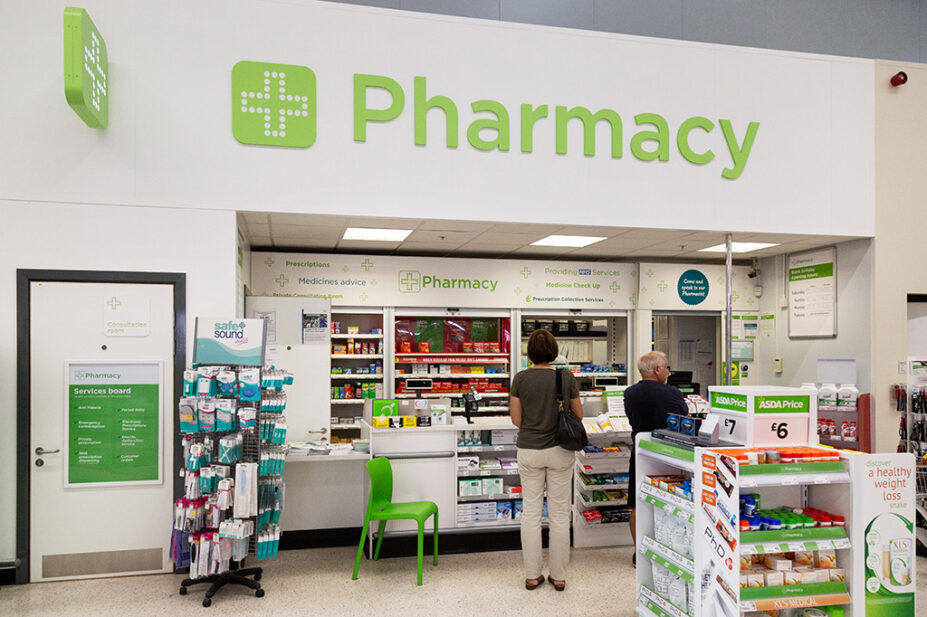
Kumar Sriskandan / Alamy Stock Photo
The continuing decline in the number of community pharmacies in England can generally be characterised as slow but steady.
NHS data show that, in 2020/2021, community pharmacy numbers fell by 190 compared with the previous year, before falling by a further 114 in 2021/2022. This steady grind has led to the lowest number of community pharmacies in England in seven years.
But then, in just one month, more than 250 in-store supermarket pharmacies were put at risk of closure across the UK in 2023, as supermarket groups and multiples cut costs, streamline operations and move services online.
Pharmacists have warned of increasing numbers of closures for years, as a result of frozen government funding, that experts warn could have catastrophic effects on health equalities for patients.
But these latest closures could be the death knell for more pharmacies nearby.
An analysis by The Pharmaceutical Journal has revealed that pharmacies at risk of shutting their doors this year could displace nearly 1 million prescriptions each month on to surrounding pharmacies, leading to what trade bodies have described as a “domino effect” of further closures.
In total, supermarkets announced potential closures of 252 pharmacies in January 2023.
The vast majority of these are Sainsbury’s-based branches of LloydsPharmacy, which announced on 19 January 2023 that it would withdraw pharmacy services from all 237 Sainsbury’s stores across the UK over the course of 2023. These include four in Scotland, four in Wales and one in Northern Ireland.
The decision, which will see the pharmacies either sold to another contractor or close, was the result of a “strategic review of its operations in response to changing market conditions”, the multiple said.
This is the latest contraction of the LloydsPharmacy chain, which already closed 259 branches between 2019 and 2022, and has chosen not to retender their contract to provide pharmacy services in Scottish prisons.
Following this, Asda announced on 26 January 2023 that it plans to close 7 of its 241 in-store pharmacies in England, “due to low customer usage”. Then, on 31 January 2023, Tesco said that it would close 8 of its 351 in-store pharmacies as part of moves “to ensure we remain focused and competitive in a fast-changing market”.
Using data on pharmacy contractor dispensing in England, published monthly by NHS Business Services Authority, The Pharmaceutical Journal has calculated that the stores earmarked for possible closure by LloydsPharmacy and Asda dispensed 984,246 prescriptions in October 2022.
This figure does not include dispensing from the nine LloydsPharmacy stores outside of England, or the eight Tesco stores. Even if some supermarket customers switch to online pharmacy services, the sector is looking at around 1 million prescriptions each month that now need to be dispensed elsewhere.
Pharmacies are no longer economically sustainable and there is a real risk that other pharmacies would not be able to pick up increased demand should pharmacies start to suddenly close
Janet Morrison, chief executive of the Pharmaceutical Services Negotiating Committee
Janet Morrison, chief executive of the Pharmaceutical Services Negotiating Committee, warns that if this large number of closures goes ahead, it will put community pharmacy in a “fragile state”.
“Any pharmacy closure will impact on a community. Patients will find it harder to get their medicines and the informal healthcare advice they have been relying on. But growing numbers of permanent closures are beginning to chip away at vital local healthcare provision,” she says.
“Pharmacies are no longer economically sustainable and there is a real risk that other pharmacies would not be able to pick up increased demand should pharmacies start to suddenly close, particularly if this happens in clusters.”
While the affected LloydsPharmacy branches are located nationwide, there are clusters in the southeast of England — 40 of the in-store Sainsbury’s pharmacies are located in Kent, Sussex and Surrey.
The Asda pharmacies include four in the north of England, one in Weston-Super-Mare, Somerset, one in Southampton, Hampshire, and one in Feltham, West London. Tesco has yet to confirm which pharmacies it plans to close, although it says it will only close outlets where there are alternative pharmacies within one mile of the store.
“The pharmacy network is in such a fragile state that we could soon see a domino effect,” says Morrison. “As patients of one wave of closures find themselves being directed to alternative pharmacies for access to medicines and pharmaceutical services, the pressures on those refuge pharmacies will increase, thereby putting them at higher risk of closure.”
Amish Patel is chair of the Kent Local Pharmaceutical Committee, where 12 LloydsPharmacy branches may close, representing around 49,000 dispensed monthly prescriptions. He says he is sure the sector will “pick up the pieces” to ensure patients have access to the pharmacy services they need, but has concerns about the impact on Kent pharmacies.
“We are resilient and put patients first. But we are struggling with workforce, funding and exhaustion,” he says, adding that the Kent area sees a lot of branded prescribing, which adversely affects profits. He says his own pharmacy had made a loss on NHS work for three years running.
“The more you dispense, the more you lose, because you’re dispensing at a loss,” he says. “We are going to take on more work [from the closed stores] but don’t necessarily have the resources to deal with it.”
In September 2022, the National Pharmacy Association (NPA) published a report warning that thousands of pharmacies are at risk of closure in the coming years without additional government funding.
However, one of the report’s authors, David Taylor, emeritus professor of pharmaceutical and public health policy at University College London, says the potential supermarket pharmacy closures are not “a huge bellwether, but at the same time they emphasise this is a sector that hasn’t seen returns”.
“At one stage, they floated the idea of supermarkets having health centres with pharmacies and GPs moving in, to drive footfall. That hasn’t appeared, the GPs didn’t move in and you can get footfall from all sorts of things. [The supermarkets] often change their tactics.”
He adds: “From what I understand, the numbers of prescriptions don’t make it look like pharmacies are profitable in supermarkets.”
The Pharmaceutical Journal’s analysis found that the average monthly dispensing figures for both Sainsbury’s and Asda in-store pharmacies are well below England’s average of 7,454 prescriptions dispensed in October 2022, at 4,210 and 3,479 prescriptions respectively (see Table).
And Taylor adds that, with around 1 billion prescriptions dispensed monthly in England, displacing 1 million means “you’re talking about 0.1% of prescriptions by volume.” He also noted that the multiple has one of the fastest-growing digital pharmacies and is likely to encourage supermarket customers to sign up to its online services.
But Gareth Jones, director of corporate affairs at the NPA, points out that “the redistribution of workload implied by the LloydsPharmacy closures will not affect all pharmacies equally”.
“Pharmacies that are in near proximity to the closed branches will probably pick up more prescriptions and also face greater demand for time-consuming, unfunded, healthcare advice. For some, this will be a considerable challenge, given existing pressures.”
Rachel Power, chief executive of The Patients Association, says news of so many potential pharmacy closures is “deeply worrying” for patients too, especially in light of plans to make greater use of community pharmacy in the NHS.
In January 2023, health secretary Steve Barclay told the House of Commons that he would like to see community pharmacies “do even more and indeed as they do in Scotland”, alluding to the country’s NHS Pharmacy First minor ailments service, to help ease pressure on general practice.
“We have consistently welcomed plans to promote the greater use of pharmacists, but we know pharmacy is struggling with recruitment and retention issues. This must be addressed if pharmacists are expected to care for patients who might otherwise visit their GP practice. We would like to see NHS England and pharmacy professional bodies push the role of pharmacy in a much more consistent way,” says Power.
Community pharmacy’s accessibility and characteristics are a huge asset to a community, so to see pharmacies closing and other pharmacies struggling to keep staff is deeply worrying to us
Rachel Power, chief executive of The Patients Association
“Community pharmacy’s accessibility and characteristics are a huge asset to a community, so to see pharmacies closing and other pharmacies struggling to keep staff is deeply worrying to us,” she says.
“Pharmacies know their communities well and if we are truly to expand the primary care offering, we cannot allow closures of multiple pharmacies in any one area.”
A spokesperson for the NHS said: “The NHS will work with government and local pharmacies over the next few months to minimise disruption to patients so that people can continue to access the medicines and advice they need.
“A dedicated search facility on the NHS website and on the NHS app can also help people find, and easily switch to, another pharmacy that is convenient to them.”
A spokesperson for LloydsPharmacy said: “The decision to withdraw LloydsPharmacy services from all Sainsbury’s branches was not an easy one to make. Nevertheless, it was taken very carefully and all the impacts were considered.”
“To help patients and customers with finding an alternative pharmacy provision, we are offering support via our website, branch and customer service teams. This involves informing them of the need to nominate a new pharmacy and signposting them to the NHS app and website in order to complete the process.”
Taylor offers some much-needed reassurance. The “established model of independent professionally-led pharmacy” is “relatively stable” and should be able to cope in the short term, he says.
“Is the system resilient? Yes, at the moment. The challenges are further up the line. I don’t think at the moment these closures are cause for alarm, but if in future we have the widespread effects of many more closures, I don’t think you should be relaxed about it.”
1 comment
You must be logged in to post a comment.



Is there not scope for the ICB to offer a new contract (in the vicinity of the closure) to provide NHS pharmaceutical services when there is a closure and the remaining local contractors cannot cope with the extra workload ?
Surely this is the rational way to ensure that local populations are not left disadvantaged because of commercial decisions made by corporate contractors who want to withdraw from providing NHS services in a locality.
It may well be the case that what may not be viable for a large corporate chain could be very viable for a small independent contractor.